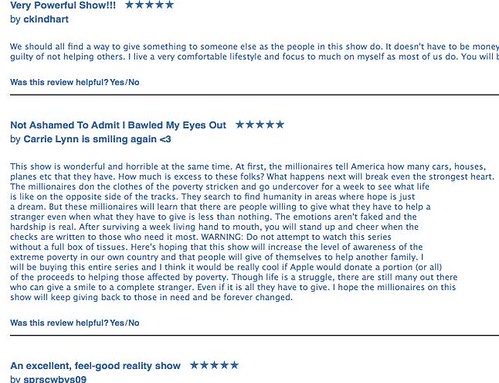
“What is a reflection? A chance to see two? When there are chances for reflections, there can always be two–or more. Only when we are everywhere will there be just one.” – Log Lady

“What is a reflection? A chance to see two? When there are chances for reflections, there can always be two–or more. Only when we are everywhere will there be just one.” – Log Lady
So in my occasional reality TV binging, I stumbled across a monstrosity. It’s on Fox (surprise!). It’s called Secret Millionaire and it makes me genuinely uncomfortable to watch. Of course I plan to use it in my classroom!
The premise is simple: get rich, privileged folk to mingle with those in “extreme poverty” for a week and then give to those individuals that they feel are most in need. Here are the actual lines displayed at the beginning of each episode with a couple of quotes from one episode:
For one week So and So will live undercover in poverty.
They will leave their possessions and identities at home.
People will be told that So and So are involved in a documentary about poverty.
They will have to survive on a welfare budget of $107.
“I’m really nervous about the story I’m going to tell people because it’s not true. I am a multi-millionaire trying to pose as an average Joe.”
“I guess my biggest fear is about safety.”
Maybe it’s the “scary” and the “sad” music that’s played when these millionaires first visit their temporary new homes. Maybe it’s the way that the poor are a sob story and two or three families become aw-shucks-feet-washing-idolaters for deceitful benefactors with open checkbooks. Maybe it’s the horrendous, stereotypical formula of the ghettoized neighborhood that reveals a few beautiful gems that deserve reward.
Part of why I’m fascinated by reality television is because it’s so far away from actual everyday experiences. There are these amazing fictions being constructed in the mundane that are interesting to look at. I like knowing about this microcosm of infighting on some island in Survivor. Or if that hem will hold on Project Runway. Or if the flight will be booked on the Amazing Race.* The problem is, I feel really uncomfortable watching the caricature of “poverty” that is edited for the prime time Fox audience. Suddenly, this reality feels a bit less familiar and a bit less lighthearted.
Looking at the show on iTunes (I’m downloading the episode where a husband and wife dare to live in Watts for a week for class discussion), I’m even more concerned by the types of comments made on the show:

We’ll see what the kids of South LA think about Secret Millionaire next week.
*Speaking of the Amazing Race, after seeing Slumdog Millionaire (another Millionaire?!?), I’m pretty sure that the reason the Amazing Race spends at least two episodes in India each season is because it’s easy to show cultural practices that look “crazy” to us westerners. Similarly, the sheer density of the cities used makes even us Angelinos gape in amazement at the insane life “over there.” I’d imagine I’d have as visceral a reaction to these episodes (and their constant reliance on the country as the “crazy country” trope) as I do to Secret Millionaire if I actually lived in Mumbai.
“What kind of music are we going to be playing, Jimmy?”
“We’re working class, right?”“We would be if there was any work.”
“So, your music should be like where you’re from and the sort of people you come from. It should speak the language of the streets. It should be struggle and sex and I don’t mean I want to hold your hand until the end of time and mushy stuff like that…”
“What kind of music says all that?”
“Soul.”
Slumdog Millionaire felt like the feel-good sequel to Manufactured Landscapes, at times.
Please go see it with this in mind.

I just watched the film The Fall. It mysteriously arrived in my mailbox in one of the regularly received red Netflix envelopes, even though I don’t have any recollection of adding it to my ‘Flix queue. (To be honest, this isn’t at all as mysterious as I it sounds. I’ve come to accept the fact that my memory is pretty much shot. Hell, I’ve come up with amazing ideas and innovations only to share them with Rhea and be told I said the same thing months before. Now that I think about it, half the films I get from Netflix are a total surprise when I actually open them up.)
In a formal way, the film is about understanding and misunderstanding and frustrations found within communication. The young protagonist, Alexandria, spends significant portions of the film asking questions and chirping “Why”. The film, without giving too much away is a man in a hospital telling a story to a young girl. The story weaves into the fantastic in a way that would fit alongside the League of Extraordinary Gentlemen (the version to which Mr. Alan Moore has actually kept his name attached). A cadre of men has all vowed to kill the evil Governor Odious for the various wrongs he has committed. This group includes:
A Masked Bandit
The Indian
The Mystic
Charles Darwin
The Escaped Slave
As the patient tells his story, he extrapolates the details that intrigue young Alexandria, telling the story he senses she wants to hear: Oops, I thought she liked pirate stories. No? Well, in that case, one of the protagonists can’t even swim.
At the same time, the film primarily shows us the story being told as Alexandria imagines it. There are occasional miscues from the patient’s story. The “Indian” and his squaw are interpreted as from the country of India. The Masked Bandit initially resembles the girl’s late-father (his dialect quickly changes as the patient adjusts to the girl’s emotional needs).
Visually, the film is stunning. I remember being excited to see The Cell because of its unique visual texture. I was completely disappointed. Here, director Tarsem knocks it out of the park. Rich but not decadent, the film feels like reasonable journey into the abstraction of childhood imagination.
As I watched the film, I couldn’t help but think about how this reaffirms my belief in storytelling as an underused teaching strategy. It also reminds me of the potential misinterpretations that come from stories. Ultimately these are just as dynamic and powerful as intended explication.
An older commercial that was just replayed during an Olympic break. In light of my recent thoughts on lowbrow literacy, class discussions about cultural reproduction, and student feelings about marketing, I think there are a lot of possibilities to take this commercial towards a place of possibilities.
Thanks Coca Cola!
Who else is thirsty?
Saw Wall-E at the El Capitan on Friday. And while the El Cap usually does a great job turning a movie into a full event, the best added feature for Wall-E was the series of Hubble telescope pictures adorning the walls of the lobby.
As far as the film, I can’t think of a more human, more touching movie I’ll likely see this year than Wall-E. This isn’t a kids film, but it’s one they (along with everyone else) should be seeing.
Lastly, as much as I am a fan of films and books with post-apocalyptic settings, I found Wall-E’s vision of the future extremely unsettling. What happened to the World Without Us?
I’ll preemptively end my thoughts on the film here as I’m on the verge of gushing endlessly. Since watching, I’ve now bought this and I’m contemplating this too.
And here are a bunch of clips I’ve been meaning to put up here for a bit:
This Largo review mentions both of my song requests. (I’m famous!)
The Southern California Library hosted a graffiti symposium in conjunction with the curricula that Mark and I have been developing. Here’s an article about it. (So famous!)
Travis Miller’s class was profiled for an article about same sex marriage. Sadly, I couldn’t be at school on this day and the spotlight had to be handed over to a much more adept educator. (Not so famous…)
LA Weekly article about Ray Cortines. Though I was interviewed, my quotes of unrelenting wisdom did not make the cut. However, this is another opportunity to link to the interview Travis and I did with Cortines. (Not famous + re-linking an old clip = quasi un-famous?)
With B-track back in session, a daily silent reading period of 15-20 minutes in each of my classes means I’m able to tackle some of the random books I’ve been accumulating. Strange as it may seem, I get through a bit more leisure reading while I’m full-on teacher mode than while I’m off track with way more free time.
When I first read the description of The Film Club By David Gilmour, way back in December, I immediately preordered the book – the premise was good enough to be a must-read: Gilmour allows his 16 year old son to drop out of school with one simple caveat. The son has to watch three films a week with his father. This is the closest that the son gets to a legitimate education throughout his high school career.
While The Film Club spends more time than I’d prefer dealing with relationship issues: miserable breakups, growing pains, crazy girlfriends, and more miserable breakups, the discussions of the time spent watching film is entertaining.
As an educator, I was particularly interested in this early passage: “I didn’t waste any time. The next afternoon, I sat him down on the blue couch in the living room, me on the right, him on the left, pulled in the curtains, and showed him Francois Truffaut’s The 400 Blows (1959). I figured it was a good way to slide into European art films, which I knew were going to bore him until he learned how to watch them. It’s like learning a variation on regular grammar.”
Though I’ve only taught one official Film Studies class (an intersession course that ranged from Style Wars to Buster Keaton), film literacy and its necessary “grammar” are the skills I continue trying to develop in my 11th and 12th grade English classes. Likewise, the conflicted dissimilitude of Antoine Doinel is perpetually present in many of my seniors; standing on the precipice between student and not-student, these are students marinating in uncertainty. Maybe a screening of The 400 Blows is worth a shot?
In related news, Matt Ruff’s Bad Monkeys was a fun, silly yarn. I admittedly picked this up because I’m a sucker for the book design, but the book has me interested in pursuing Ruff’s previous books.
Currently really enjoying Chip Kidd’s The Learners (a sequel to the underrated The Cheese Monkeys). I suspect I’ll need to go back to the Beyond Pedagogy texts after this one, to stay on top of things.
Oh and I’m only a third of the way through Infinite Jest but the hyperbolic praise that the book’s garnered is becoming more solidified with each page read. (As I was looking up the book – I noticed that the current version of the text is only $6.29 on Amazon. Though not the edition I’m reading, this is an absolute steal. At slightly more than 1100 pages long, the cost breaks down to about sixty cents per hundred pages. I can ascertain it’s a text that will keep you busy and cerebrally entertained.)
Note: Though this isn’t technically a 101 post, it’s been tagged as such for personal reference. Pay no mind.
“This is where perfection begins.”
I have more to say, but it may be said elsewhere and elaborated here.
Can’t offer anything insightful about No Country For Old Men. Probably the best film I’ve seen this year… still holding out for There Will Be Blood. Can’t think of too many other book adaptations that are this good.